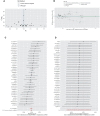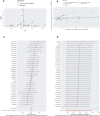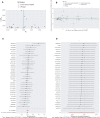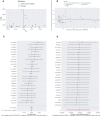Causal relationship between type 1 diabetes mellitus and six high-frequency infectious diseases: A two-sample mendelian randomization study
- PMID: 37065754
- PMCID: PMC10102543
- DOI: 10.3389/fendo.2023.1135726
Causal relationship between type 1 diabetes mellitus and six high-frequency infectious diseases: A two-sample mendelian randomization study
Abstract
Purpose: Type 1 diabetes mellitus (T1DM) is associated with different types of infections; however, studies on the causal relationship between T1DM and infectious diseases are lacking. Therefore, our study aimed to explore the causalities between T1DM and six high-frequency infections using a Mendelian randomization (MR) approach.
Methods: Two-sample MR studies were conducted to explore the causalities between T1DM and six high-frequency infections: sepsis, acute lower respiratory infections (ALRIs), intestinal infections (IIs), infections of the genitourinary tract (GUTIs) in pregnancy, infections of the skin and subcutaneous tissues (SSTIs), and urinary tract infections (UTIs). Data on summary statistics for T1DM and infections were obtained from the European Bioinformatics Institute database, the United Kingdom Biobank, FinnGen biobank, and Medical Research Council Integrative Epidemiology Unit. All data obtained for summary statistics were from European countries. The inverse-variance weighted (IVW) method was employed as the main analysis. Considering the multiple comparisons, statistical significance was set at p< 0.008. If univariate MR analyses found a significant causal association, multivariable MR (MVMR) analyses were performed to adjust body mass index (BMI) and glycated hemoglobin (HbA1c). MVMR-IVW was performed as the primary analysis, and the least absolute shrinkage and selection operator (LASSO) regression and MVMR-Robust were performed as complementary analyses.
Results: MR analysis showed that susceptibility to IIs increased in patients with T1DM by 6.09% using the IVW-fixed method [odds ratio (OR)=1.0609; 95% confidence interval (CI): 1.0281-1.0947, p=0.0002]. Results were still significant after multiple testing. Sensitivity analyses did not show any significant horizontal pleiotropy or heterogeneity. After adjusting for BMI and HbA1c, MVMR-IVW (OR=1.0942; 95% CI: 1.0666-1.1224, p<0.0001) showed significant outcomes that were consistent with those of LASSO regression and MVMR-Robust. However, no significant causal relationship was found between T1DM and sepsis susceptibility, ALRI susceptibility, GUTI susceptibility in pregnancy, SSTI susceptibility, and UTI susceptibility.
Conclusions: Our MR analysis genetically predicted increased susceptibility to IIs in T1DM. However, no causality between T1DM and sepsis, ALRIs, GUTIs in pregnancy, SSTIs, or UTIs was found. Larger epidemiological and metagenomic studies are required to further investigate the observed associations between the susceptibility of certain infectious diseases with T1DM.
Keywords: infections; intestinal; lower respiratory; mendelian randomization; pregnancy; sepsis; skin; urinary tract.
Copyright © 2023 Chen, Liu, Nie, Wang and Xiang.
Conflict of interest statement
The authors declare that the research was conducted in the absence of any commercial or financial relationships that could be construed as a potential conflict of interest.
Figures







Similar articles
-
Causal relationship between type 1 diabetes mellitus and mycoses: a Mendelian randomization study.Front Med (Lausanne). 2024 Jun 14;11:1408297. doi: 10.3389/fmed.2024.1408297. eCollection 2024. Front Med (Lausanne). 2024. PMID: 38947239 Free PMC article.
-
Causal associations between type 1 diabetes mellitus and cardiovascular diseases: a Mendelian randomization study.Cardiovasc Diabetol. 2023 Sep 2;22(1):236. doi: 10.1186/s12933-023-01974-6. Cardiovasc Diabetol. 2023. PMID: 37659996 Free PMC article.
-
Causal relationship between blood metabolites and risk of five infections: a Mendelian randomization study.BMC Infect Dis. 2023 Oct 7;23(1):663. doi: 10.1186/s12879-023-08662-6. BMC Infect Dis. 2023. PMID: 37805474 Free PMC article.
-
Multivariable Mendelian Randomization and Mediation.Cold Spring Harb Perspect Med. 2021 Feb 1;11(2):a038984. doi: 10.1101/cshperspect.a038984. Cold Spring Harb Perspect Med. 2021. PMID: 32341063 Free PMC article. Review.
-
Causal factors underlying diabetes risk informed by Mendelian randomisation analysis: evidence, opportunities and challenges.Diabetologia. 2023 May;66(5):800-812. doi: 10.1007/s00125-023-05879-7. Epub 2023 Feb 14. Diabetologia. 2023. PMID: 36786839 Free PMC article. Review.
Cited by
-
Association of mental disorders with sepsis: a bidirectional Mendelian randomization study.Front Public Health. 2024 May 17;12:1327315. doi: 10.3389/fpubh.2024.1327315. eCollection 2024. Front Public Health. 2024. PMID: 38827616 Free PMC article.
-
Causal relationship between type 1 diabetes mellitus and mycoses: a Mendelian randomization study.Front Med (Lausanne). 2024 Jun 14;11:1408297. doi: 10.3389/fmed.2024.1408297. eCollection 2024. Front Med (Lausanne). 2024. PMID: 38947239 Free PMC article.
-
Associations between type 2 diabetes mellitus and chronic liver diseases: evidence from a Mendelian randomization study in Europeans and East Asians.Front Endocrinol (Lausanne). 2024 Mar 1;15:1338465. doi: 10.3389/fendo.2024.1338465. eCollection 2024. Front Endocrinol (Lausanne). 2024. PMID: 38495785 Free PMC article.
References
Publication types
MeSH terms
Substances
LinkOut - more resources
Full Text Sources
Medical

